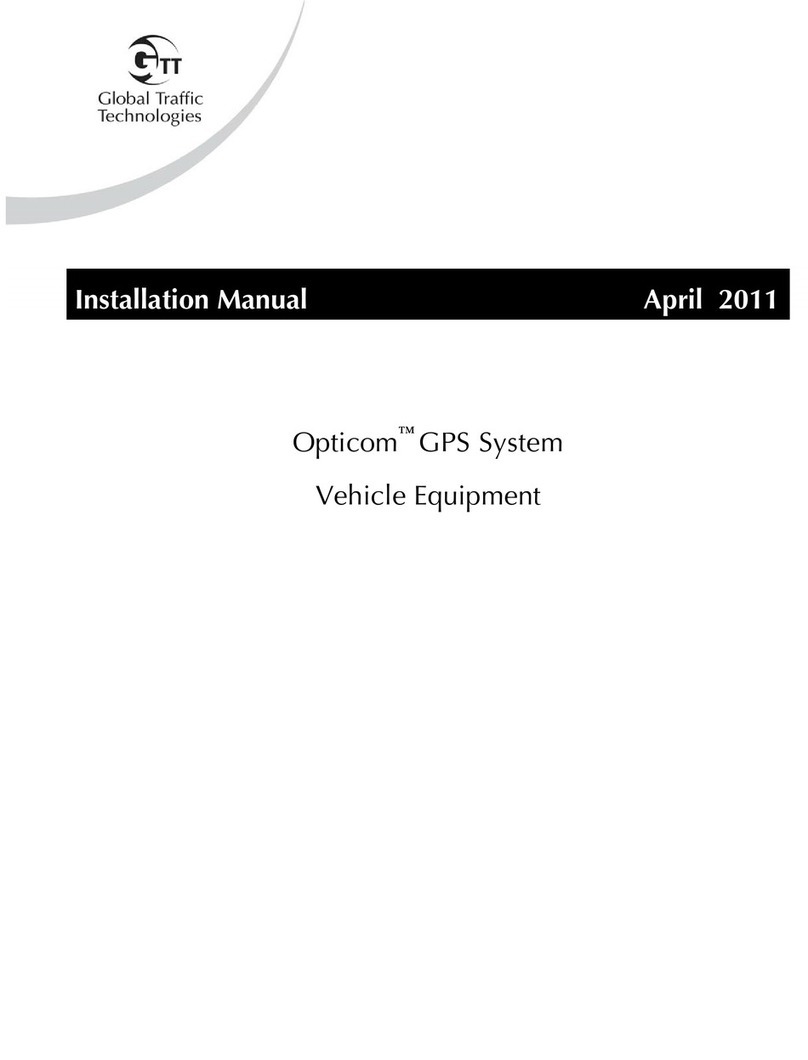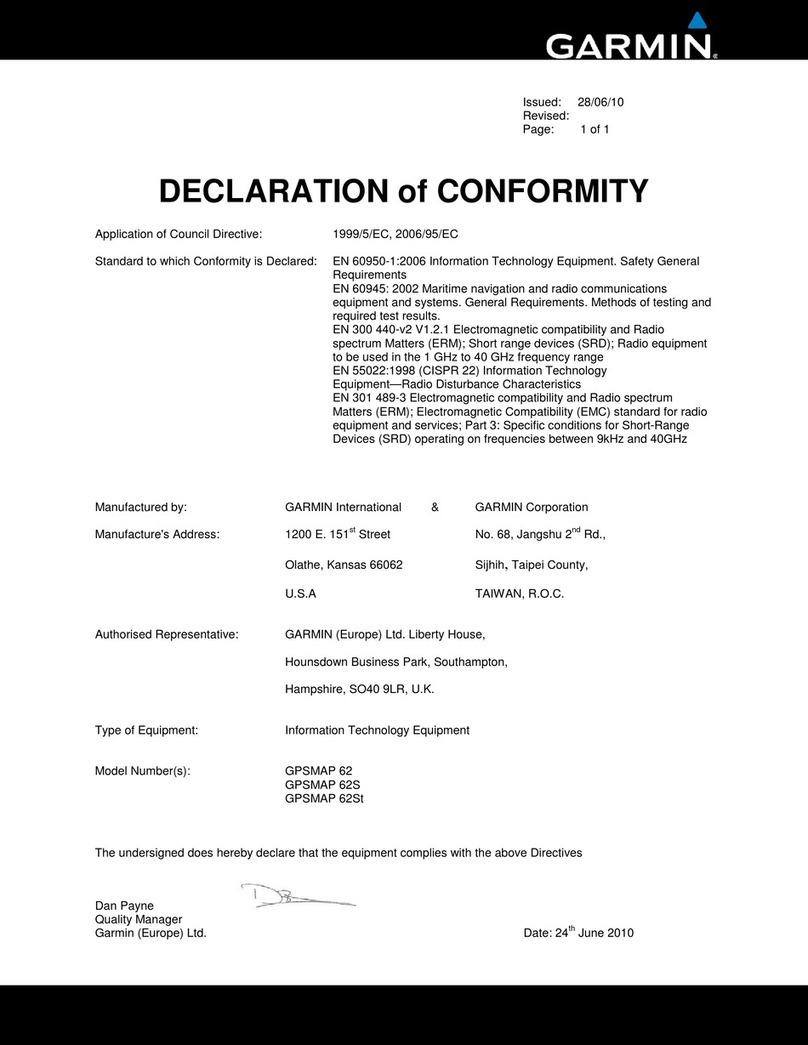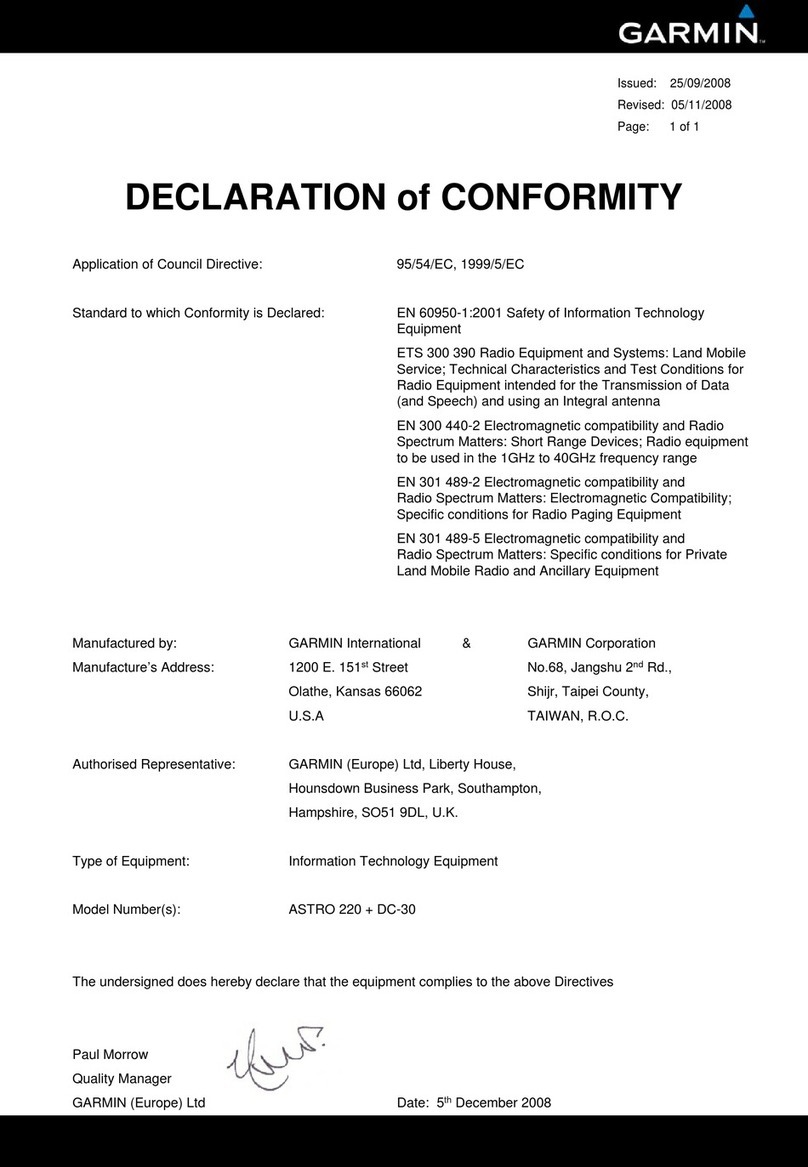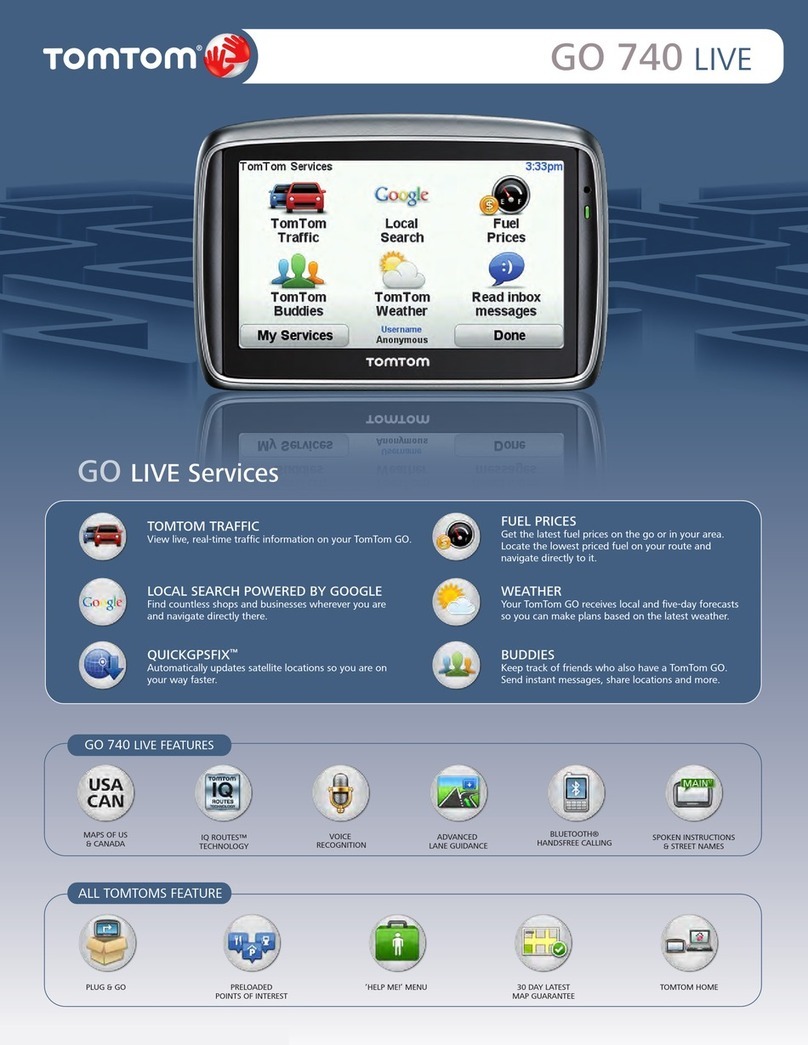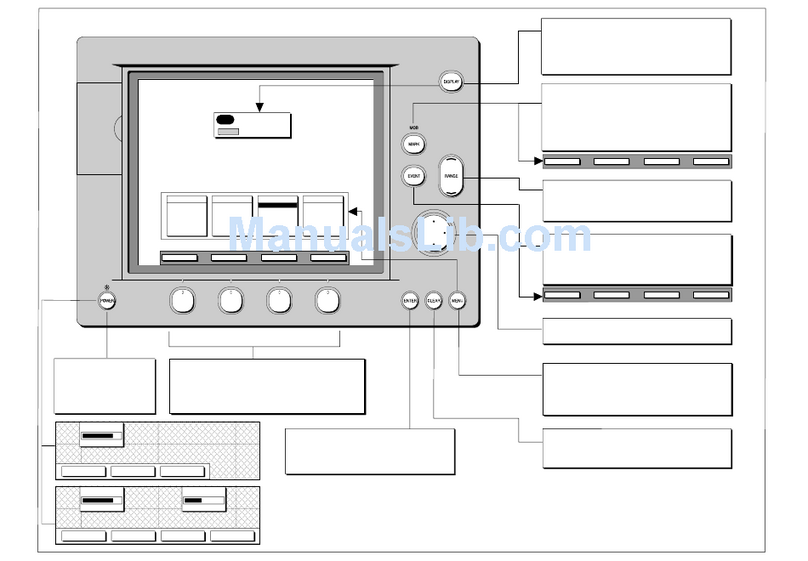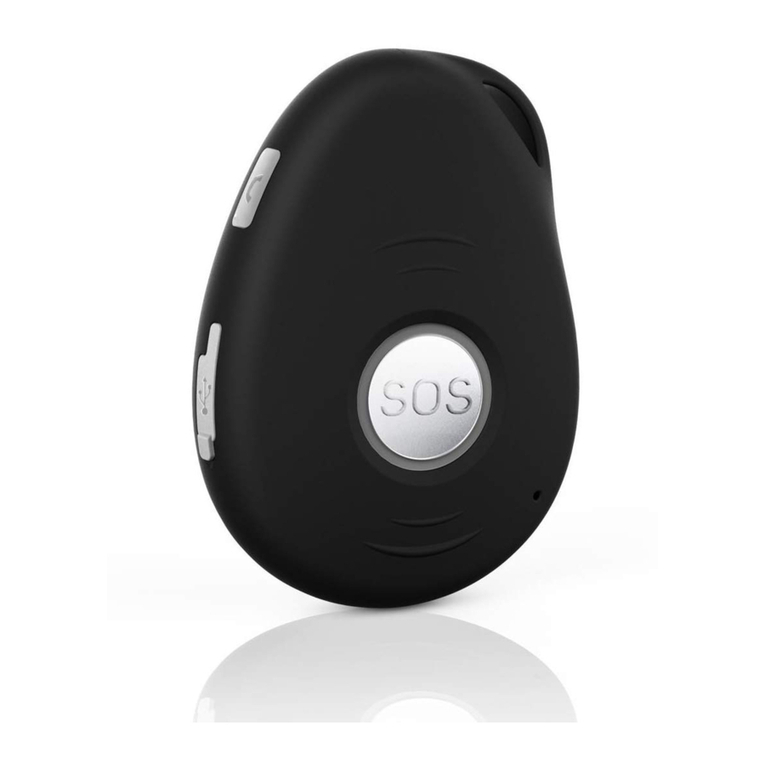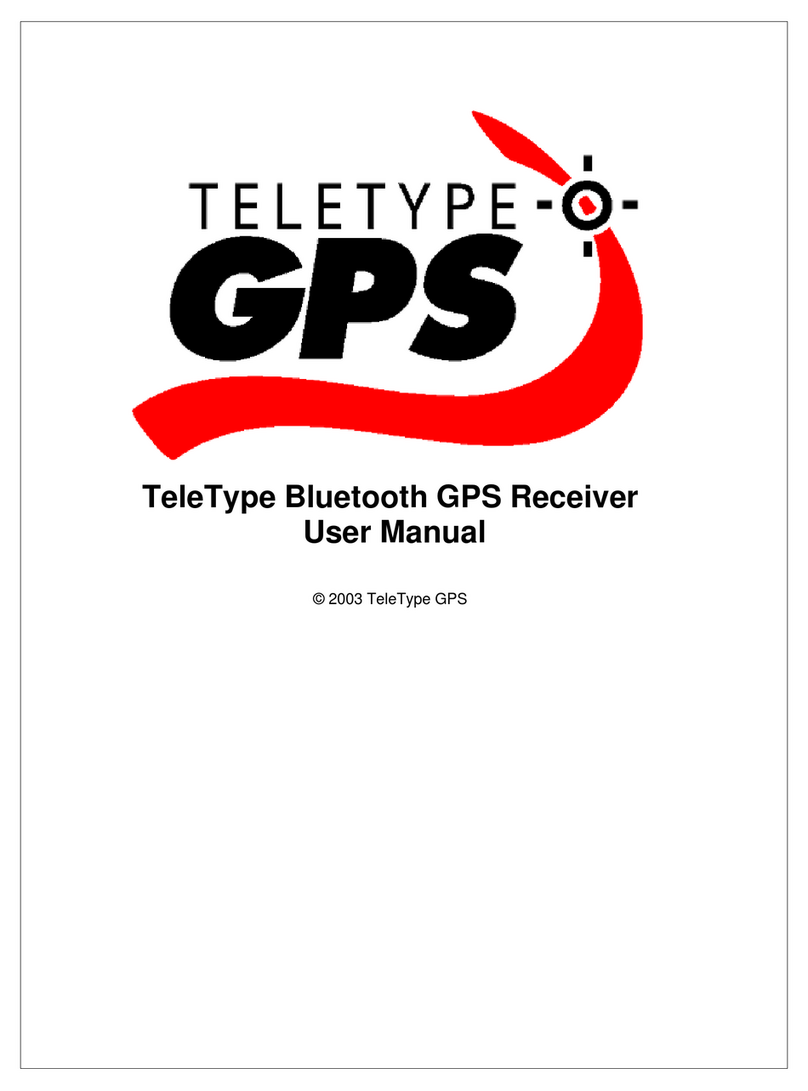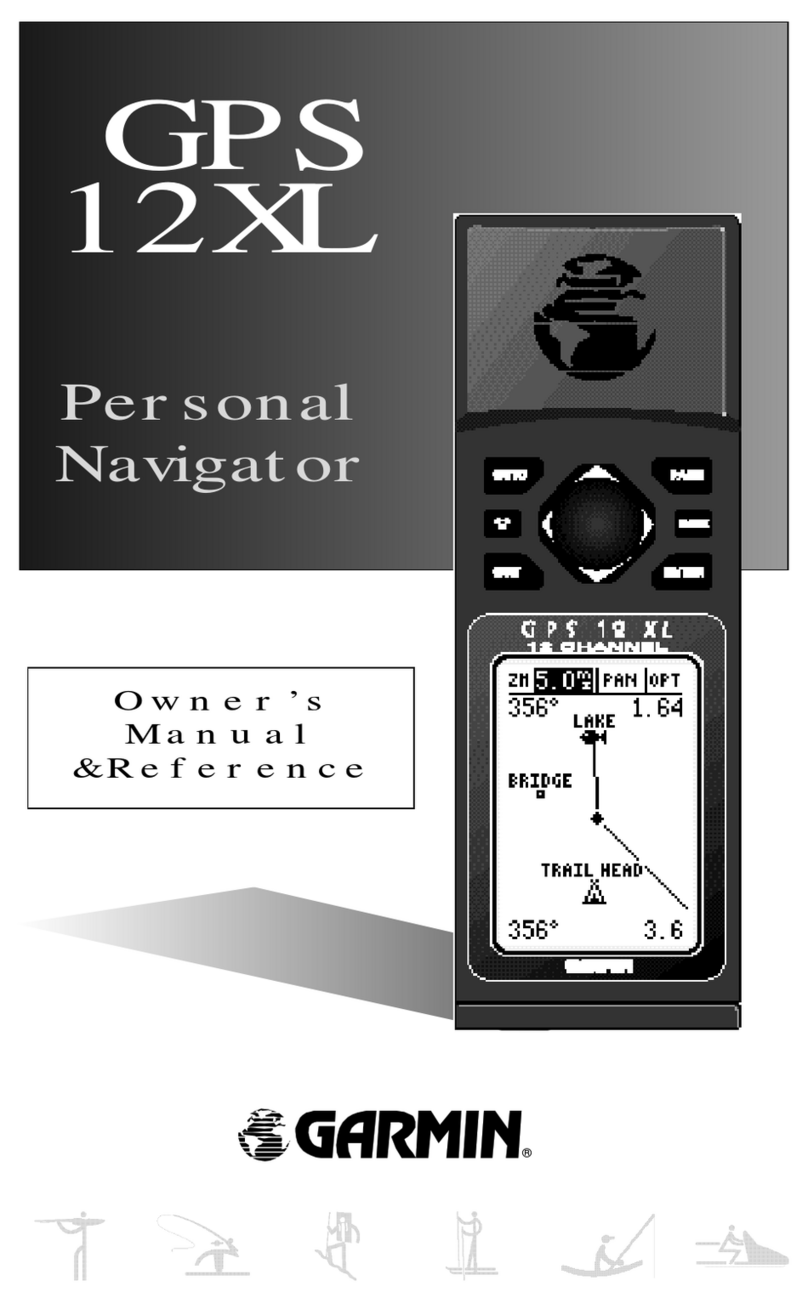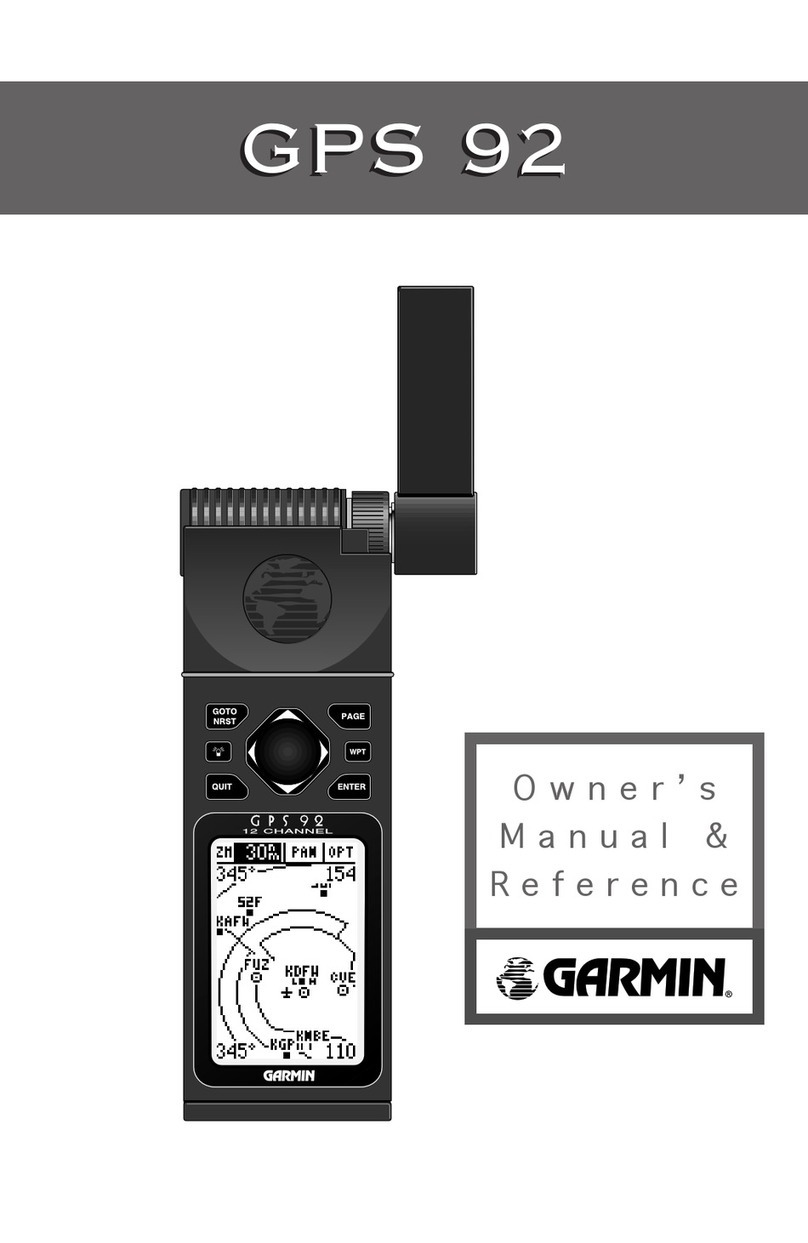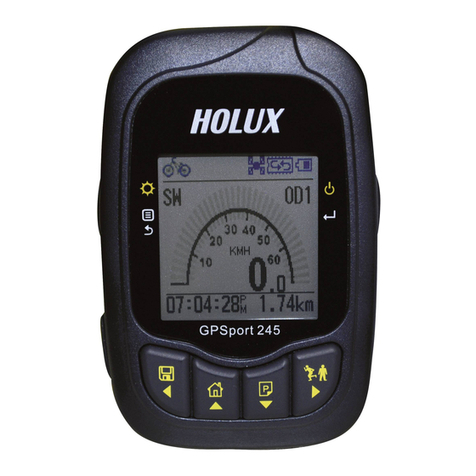Global Traffic Technologies Opticom 2100 Series User manual

OpticomGPS System
Vehicle Equipment
Model 2100 Series
Installation Manual May 2013

Vehicle Equipment Installation Instructions
2
Table of Contents
1About This Manual ...........................................................................................................................................3
1.1 Intended Use.............................................................................................................................................3
1.2 Technical Support ....................................................................................................................................3
2Safety Information............................................................................................................................................3
2.1 Label Locations......................................................................................................................................... 4
2.2 Safety Considerations............................................................................................................................... 5
2.3 FCC and IC Statement..............................................................................................................................6
3Description........................................................................................................................................................6
3.1 Opticom™ GPS System...........................................................................................................................6
3.2 Vehicle Equipment................................................................................................................................... 7
3.3 Parts List ....................................................................................................................................................8
3.4 Features .....................................................................................................................................................9
3.5 Specifications.......................................................................................................................................... 10
4Installation.......................................................................................................................................................11
4.1 Model 1050 Radio/GPS antenna installation ......................................................................................12
4.1.1 Antenna location considerations ..................................................................................................12
4.1.2 Antenna Installation .......................................................................................................................12
4.1.3 Model 79XHM, Model 79XTM.....................................................................................................14
4.2 Radio/GPS Control Unit (RGCU) Installation......................................................................................15
4.3 Cable connections.................................................................................................................................. 16
5Wiring Connections .......................................................................................................................................17
5.1 Power and Ground Connections ..........................................................................................................19
5.2 Lightbar or Ignition Sense Connection.................................................................................................19
5.2.1 Activation Methods and Switch settings ......................................................................................20
5.2.1.1 Emergency Vehicle Activation methods: .............................................................................21
5.2.1.2 Transit Vehicle Activation methods: ....................................................................................21
5.2.1.3 Maintenance Vehicle Activation Methods ..........................................................................21
5.3 Turn Signal Sensing Connections .........................................................................................................22
5.4 Disable Sense Connection.....................................................................................................................23
5.5 Low Priority (optional) ...........................................................................................................................24
5.6 Probe Priority (optional) ........................................................................................................................24
5.7 J1708 Connections (optional) ...............................................................................................................25
5.8 GPS Output (optional) ...........................................................................................................................26
5.9 Other connections (optional)................................................................................................................27
5.10 Model 2173 Adapter for using previous generation harness.............................................................27
6Infrared Emitter connections (optional) ......................................................................................................28
7Configuration and Checkout.........................................................................................................................30
7.1 Configuration Setup ...............................................................................................................................31
7.2 Input Verification....................................................................................................................................32
7.2.1 Turn Signal input verification........................................................................................................ 32
7.2.2 Disable Input Verification .............................................................................................................33
7.2.3 Probe and Low Priority Input Verification................................................................................... 33
7.3 Transmit and Receive Verification .......................................................................................................33
7.3.1 Verifying with two vehicles........................................................................................................... 33
7.3.2 Verifying using an Intersection ..................................................................................................... 34
8Communication Ports ....................................................................................................................................35
8.1 RS-232 Communication Port ................................................................................................................35
8.2 USB Port..................................................................................................................................................35
8.3 Ethernet Port............................................................................................................................................36
9Troubleshooting..............................................................................................................................................37
10 Maintenance....................................................................................................................................................38

Vehicle Equipment Installation Instructions
3
1About This Manual
This manual provides step-by-step instructions for installing the Global Traffic Technologies
Opticom™ GPS System* vehicle equipment. It is intended for use by installers, maintenance
personnel, and others who are responsible for the installation and maintenance of the system.
1.1 Intended Use
The system is intended to assist authorized priority vehicles through signalized intersections by
providing temporary right-of-way through vehicle operator interface to the system and through the
use of common traffic controller functions. GTT has not evaluated this product for use in any other
application*.
1.2 Technical Support
If you have questions about the system, its use, or operation, please contact your dealer or call
the GTT Technical Service department at 1-800-258-4610.
2Safety Information
We provide important safety information and warnings to assist you in understanding and
avoiding potential harm to yourself, and possible damage to equipment, during the installation
of Opticom™ GPS System equipment. Although we have included many potential hazards
you may encounter during the installation of this equipment, we cannot predict all of the
possible hazards and this list should not be a substitute for your judgment and experience.
Please read, understand, and follow all safety information contained in these instructions
before installing the system equipment. Save this installation manual and keep it near the
equipment.
If you are unsure about any part of this installation or of the potential hazards discussed, please
contact your supervisor immediately.
*The method of using the components of the OpticomGPS system may be covered by one or
more of US Patent Numbers 5539398, 5926113, 5986575, 6243026.

Vehicle Equipment Installation Instructions
4
2.1 Label Locations
There are fuse size safety labels, FCC/IC labels on the Opticom™ GPS System vehicle
equipment. If a label is missing or cannot be read, please contact your dealer or the GTT Repair
department for a replacement.
Labels listing the fuse size are included with the installation kit and should be placed by the
installer next to the fuse holders. Fuses are ATC-2.
The FCC/IC Label is located on the Radio/GPS Control Unit.
CAUTION
Failure to replace the fuse size as marked may
cause property damage. Replace fuse size as
marked.
Figure 2-1. Vehicle Equipment Fuse Safety Label Location
Figure 2-2. FCC, IC Label Location

Vehicle Equipment Installation Instructions
5
2.2 Safety Considerations
Please consider the following safety issues before beginning the installation of the Opticom™ GPS
System vehicle equipment.
Although we have compiled this list of common safety considerations, it should not be
considered as complete. It is not intended to take the place of your good judgment, training, and
experience.
Personal Safety Equipment and Clothing
Personal safety equipment and clothing including high visibility vests, hard hats, gloves, electrical
shock or electrocution protection clothing and equipment, safety shoes, safety glasses, face
shields, goggles, and hearing protection devices are just some of the items available to you.
Choose the right equipment for the job. If you are unsure of which safety equipment is
recommended or appropriate for the job, ask your supervisor or foreman.
Electric Shock
As a trained installer of electrical equipment you are aware of the dangers associated with
installation of electrical devices. Always be sure that the power to the equipment, and all
associated equipment, is turned off and the vehicle battery is disconnected. Use the equipment,
techniques, and procedures that you learned during your training or apprenticeship or other
electrical industry recognized safety procedures.
If you are unsure of which techniques, procedures, and protective equipment are recommended or
appropriate for the job, ask your supervisor or foreman.
Explosion
Common automotive-type batteries produce an explosive gas under some conditions. This gas
may easily be ignited by a spark or flame as you work on the vehicle. To reduce the risk of
explosion, disconnect the battery, work in a well ventilated area, avoid the use of devices that
create sparks or use open flames, and use the appropriate personal safety equipment and
clothing.
If you are unsure of which techniques, procedures, and protective equipment are recommended or
appropriate for the job, ask your supervisor or foreman.
Chemical Burns
Common automotive-type batteries contain strong acid that can cause personal injury if you come
in contact with the acid. To reduce exposure to the risk of chemical burns, wear appropriate
protective clothing and handle the battery with care.
If you are unsure of which techniques, procedures, and protective equipment are recommended or
appropriate for the job, ask your supervisor or foreman.
Disposal of Device
Please dispose of the device in accordance with all local, state, and federal laws and
regulations.

Vehicle Equipment Installation Instructions
6
2.3 FCC and IC Statement
FCC Statement:
This device complies with part 15 of the FCC rules. Operation is subject to the following two
conditions: (1) This device may not cause harmful interference, and (2) this device must accept
any interference received, including interference that may cause undesired operation.
This product contains a certified radio transmitter module labeled with FCC ID: VJB-
OPTICOMGPS2
Industry Canada Statement:
This Class A digital apparatus complies with Canadian ICES-003.
Cet appareil numérique de la classe A conforme à la norme NMB-003 du Canada.
This product contains an approved radio transmitter module labeled with IC: 7275A-
OPTICOM2
A label is located on the equipment with the FCC and IC information. See Figure 2-2 for the
location of the label.
3Description
This section provides a general description of the Opticom™ GPS system and a detailed
description of the vehicle equipment.
3.1 Opticom™ GPS System
The Opticom™ GPS system assists authorized priority vehicles through signalized intersections
by providing temporary right-of-way through the use of common traffic controller functions.
The Opticom™ GPS system consists of the following matched components:
The vehicle equipment is mounted on the priority vehicle. Its GPS receiver acquires position
information from the constellation of GPS satellites. This information is used to compute the
location, speed, and heading of the vehicle. This information, along with a priority request and the
state of the vehicle’s turn signal, and ID information is broadcast using the 2.4 GHz transceiver.
The intersection equipment receives the radio transmission from the vehicle equipment. The
intersection equipment then compares the information being received from the vehicle to the
parameters stored in the intersection equipment’s memory. If the vehicle is heading toward the
intersection in a predefined approach corridor, is requesting preemption and has met all other
programmed parameters, the corresponding phase selector output is activated. This output is
connected to the traffic controller preemption input. When activated, the controller cycles to
grant a green light to the requesting vehicle or holds the green allowing the vehicle to pass
through the intersection.

Vehicle Equipment Installation Instructions
7
3.2 Vehicle Equipment
The Opticom™ GPS System vehicle equipment is intended for use on priority vehicles. The
vehicle equipment consists of a Radio/GPS Control Unit (RGCU) containing a GPS receiver and a
2.4 GHz transceiver. The RGCU also provides an interface point to the vehicle wiring, and an
external PC used for configuration and diagnostics. A radio/GPS antenna is also a component of
the vehicle equipment.
Figure 3-1 shows a typical vehicle equipment installation for a priority vehicle.
Figure 3-1. Typical Vehicle Equipment Installation for Priority Vehicle
1. Radio/GPS antenna 6. Battery
2. Left turn signal sense 7. Fuse
3. Right turn signal sense 8. Light bar/ignition sense
4. Vehicle interface harness 9. Radio/GPS antenna cable
5. Radio/GPS control unit 10. Disable switch

Vehicle Equipment Installation Instructions
8
3.3 Parts List
The following is a list of components in the vehicle kit. See Figure 3-1 for more details.
1Model 1050 Radio/GPS antenna
•
White 3” diameter dome with two 15’ cables.
5*Model 2100 Series Radio/GPS Control Unit.
•
Black module with ON/OFF switch and indicators
•
Mounting bracket and screws.
4Model 2071 Vehicle Interface Harness
•
25’ Cable with a DB-25 connector and 25’ of un-terminated loose wires
Miscellaneous parts
•
Fuse holder
•
2 amp fuse
•
Fuse label
•
Butt splice(2)
•
Installation Instructions
* Model 2100, 2150 units are factory programmed to high priority.
Model 2101, 2151 units are factory programmed to low priority.
Optional Parts
The following items are not included in the kit but are available separately.
•Model 2173 Cable adapter (see section 5.10)
•Antenna Stud extender (see section 4.1.2)
•Spare parts are also available separately.

Vehicle Equipment Installation Instructions
9
3.4 Features
Opticom™ GPS system vehicle equipment has the following features:
•Operates on 10-36 VDC
•Sense line inputs 10-36 VDC
•25-foot interface cable for installation flexibility
•Configurable Disable mode with multiple activation and operational behavior options.
•Configurable remote activation input with multiple switch selectable activation and
operational behavior options.
•Configurable turn signal sense inputs with multiple activation options.
•Front Panel diagnostic indicators
•Vehicle identification encoding; selectable at installation
•Capability to control an Opticom™ Infrared emitter through single control module
•Wide operational temperature range: –30°F to +165°F (–34°C to +74°C)
•Meets FCC part 15
•This device complies with European Standard EN 50498: 2010 “Electromagnetic Compatibility
(EMC)
•Meets SAE J1455 Section 4.11 Operational Shock Test
•Meets J575 Section 4.2 Vibration Test
•RS-232 Serial port
•USB 2.0Port
•10/100 Ethernet port
•J1708 interface
•GPS data output in NMEA format for other onboard uses
•Option to add additional radio for other applications (future)
•Option to add dead reckoning unit (future)
•Available adapter for upgrading from previous generation equipment without rewiring
•Available Windows™1Configuration and Maintenance Software
1Windows is a trademark of Microsoft Corporation.

Vehicle Equipment Installation Instructions
10
3.5 Specifications
•Opticom™ Model 2100 Series GPS vehicle control unit
oLength: 7.25 in. (18.4 cm)
oWidth: 5.44 in. (13.8 cm)
oHeight: 1.63 in. (4.1 cm)
oWeight: 1.2 lb. (0.54 kg)
•Opticom™ Model 1050 GPS/radio antenna
oLength: 15.0 ft. (4.6 m)
oDiameter: 2.85 in. (7.2 cm)
oHeight: 1.4 in. (3.5 cm)
oWeight with cables: 0.6 lbs. (0.30 kg)
•Model 2071 Vehicle Interface Harness
oLength: 25’
oSee table 5-1 for wire sizes
•Environmental
oTemperature: -30° F to +165° F (-34° C to +74° C)
oRelative humidity: 5% to 95%
•Electrical
oInput voltage: 10–36 VDC
oSense line inputs 10-36 VDC
oCurrent: Less than 2 amps
oSee Infrared emitter manual for emitter electrical specifications

Vehicle Equipment Installation Instructions
11
4Installation
This section describes the installation of the Opticom™ GPS System vehicle equipment.
Please read and fully understand the following paragraphs before starting the installation.
•Before cutting or drilling any openings in the vehicle or light bar, draw a diagram showing
placement, measurements, and dimensions. Use the diagram to avoid drilling or cutting
holes in undesirable locations.
•Always follow the vehicle manufacturer's recommendations for modification, alteration,
and installation or connection of accessories or equipment to the vehicle and light bar.
•Installation on specialty vehicles (such as motorcycles, parking enforcement, utility and
special maintenance vehicles) requires particular care and attention to details.
•Wires that are routed under carpets or mats should be run between the pad and the carpet.
This will minimize abrasion and heat damage from catalytic converters.
•Protect cables with armor or sheathing when they are routed around sharp corners and edges.
Avoid routing cables through potential pinch points. Clamp or tie all cables in place. Route
and secure cables well away from moving parts.
•Do not modify the radio/GPS unit circuitry. There are no user serviceable parts inside.
IMPORTANT NOTE WARNING
Modifying the radio/GPS unit may seriously
damage the equipment and void the warranty.
Do not attempt to modify the radio/GPS
circuitry in any way. Modifying the radio and/or
antenna in any way may cause the radio to
violate FCC/IC requirements.
Vehicle batteries contain sulfuric acid and may
contain explosive gases. Keep sparks, flames,
and cigarettes away. Wear eye protection.
Disconnect the negative cable first to prevent
shorting the positive terminal to the chassis
when removing the positive cable. Battery acid
may cause skin irritation and eye injury.
Explosive gases may cause severe injury or
death.

Vehicle Equipment Installation Instructions
12
4.1 Model 1050 Radio/GPS antenna installation
The antenna cables are 15’ long. When choosing a location for the radio/GS antenna and the
vehicle control unit, be sure that the cables are long enough to reach the location of the vehicle
control unit. Choose other locations/ if necessary.
4.1.1 Antenna location considerations
WARNING
The antenna has been approved for mobile
applications where the antenna should be used
at distances greater than 20 cm from the human
body (with the exception of hands, wrists, feet
and ankles). Operation at distances less than
20cm is strictly prohibited.
•Do not mount the radio/GPS antenna within 18 inches of any other radio antenna. Follow
the installation instructions to avoid possible radio frequency interference problems.
•Never operate the equipment with the antenna cables disconnected or the equipment may
be damaged.
•The radio/GPS antenna should be mounted level and as high on the vehicle as possible. The
radio/GPS antenna should have an unobstructed view of at least 50% of the sky.
•The radio/GPS antenna must not be obstructed by light bars, speakers, antennas, or other
devices especially towards the front of the vehicle.
•Do not paint the radio/GPS antenna cover. Metals or metal oxides in the paint may interfere
with GPS reception and/or radio reception and transmission.
4.1.2 Antenna Installation
1. Remove interior panels and headliners, as necessary, to provide access for cable routing.
1. Remove the nut and washer from the Radio/GPS antenna.
2. Drill a 5/8 to 3/4-inch hole. See Figure 4-1.
3. Route the cables through the hole and replace the lock washer and nut.
4. Tighten the nut with a15/16” wrench (a 24 mm wrench may be used if a 15/16’ wrench is not
available)
a. Do not over tighten the nut or the antenna may be damaged. 5 ft/lbs is the
recommended torque.
5. Apply silicone RTV (not provided) around the antenna if the roof curvature prevents a good
seal with the antenna’s built-in gasket.
6. If necessary alternate mounting brackets are available for mounting on vehicle mirrors, vertical
posts and trunk lids. These brackets are available from Mobile Mark Communications
Antennas (www.mobilemark.com, 1-800-648-2800). The part numbers are SM-MM (mirror
mount) and SM-TM (trunk lid mount). When using these mounts, GTT recommends that the
bottom of the antenna where the cables exit be sealed with RTV. Also care should be taken to
protect the cables where they enter into the vehicle.
7. An adapter for thicker roofs is available. Contact GTT Technical Service at 1-800-258-4610
for details.

Vehicle Equipment Installation Instructions
13
Figure 4-1. Mounting Radio/GPS Antenna on Priority Vehicle
1. Vehicle radio/GPS antenna 4. Radio and GPS antenna cables
2. Vehicle mounting surface 5. 5/8 to 3/4-inch mounting hole
3. Antenna nut 6. Antenna lock washer

Vehicle Equipment Installation Instructions
14
4.1.3 Model 79XHM, Model 79XTM
WARNING
The antenna has been approved for mobile
applications where the antenna should be used
at distances greater than 20 cm from the human
body (with the exception of hands, wrists, feet
and ankles). Operation at distances less than
20cm is strictly prohibited.
This section describes the use of the Model 79XHM and the 79XTM multimode emitters. The
multimode emitter contains an infrared emitter. The multimode emitter also contains radio and
GPS antennas that perform the same function as the Model 1050 radio/GPS antenna described in
section 5.2.
1. Refer to the manual that was included with the Model 79XXM for details on installation and
wiring.
2. See Section 7 for details on wiring the 79XXM emitter to the vehicle control unit.
3. Proceed to 4-3 for details on terminating the antenna cables
Figure 4-2. Model 79XHM, 79XTM multimode emitter

Vehicle Equipment Installation Instructions
15
4.2 Radio/GPS Control Unit (RGCU) Installation
This section describes the installation of the Model 2100 Series Radio/GPS Control Unit.
Notes:
•The radio/GPS control unit must not be in the path of airbag deployment.
•Use care when drilling holes to avoid drilling into undesirable locations.
•The location of the radio/GPS control unit must be within the 15’ cable run of the antenna
cables (or 25’ if using 794XM).
1. Determine the desired location to mount the radio/GPS control unit. Mark and drill two
7/32-inch holes, using the control unit mounting bracket as a template.
2. Insert the two 10-32 x 3/4-inch cap screws through the holes in the mounting bracket and
mounting surface. See Figure 4-3.
3. Use the two lock washers and 10-32 nuts to secure the bracket to the vehicle.
Figure 4-3. Control Unit Mounting Bracket Installation
1. 10-32 nut (2) 4. Mounting surface
2. Lock washer (2) 5. Mounting bracket
3. 7/32-inch hole (2) 6. 10-32 x 3/4-inch cap screw (2)

Vehicle Equipment Installation Instructions
16
4.3 Cable connections
1. Remove interior panels and headliners, as necessary, to provide access for cable routing.
2. Route the cables from the radio/GPS antenna (or 79XXM) through the vehicle to the back of
the radio/GPS control unit. See Figure 4-4.
3. Coil up any excess cable.
a. When coiling excess cable do not create any sharp bends in the cable or the cable may
be damaged.
4. Connect the cable labeled GPS to the GPS connector.
5. Connect the cable labeled 2.4 GHz to the 2.4 GHz connector.
6. Tighten the connectors using a 5/16” wrench (an 8 mm wrench may also be used).
a. Do not over tighten the connectors.
Notes:
•The connectors are keyed and cannot be connected to the wrong connector.
•To avoid damage to the equipment always connect the GPS and Radio connectors
before connecting the vehicle interface cable.
•Never operate the equipment with the antenna cables disconnected.
7Connect the vehicle interface cable to the J2 connector on the radio/GPS control
unit.
8Place the radio/GPS control unit into the mounting bracket. Use the two 1/4-inch acorn nuts
and lock washers to secure the radio/GPS control unit to the bracket. See Figure 4-5.
9Route the wires of the vehicle interface harness to the appropriate connection points. See
section 5 for details.
Figure 4-4. Radio/GPS Control Unit Connections
1. Radio/GPS control unit 4. GPS Cable
2. Infrared emitter terminal strip 5. Radio cable
3. Vehicle interface harness

Vehicle Equipment Installation Instructions
17
Figure 4-5. Radio/GPS Control Unit Installation
1. Mounting bracket 3. Acorn nut (2)
2. Lock washer (2) 4. Radio/GPS control unit
5Wiring Connections
This section wiring describes the wiring connections in the vehicle. The connections are made via
the Model 2171 vehicle interface harness. Table 5-1 shows the connector pin number, wire color,
and function for each wire. The harness contains wires which may not be used in all installations.
Some wires are for future applications The wires in bold are typically used in all installations..
You may cut off excess and unused wires or leave them at factory length in case the equipment is
moved in the future. Figure 5-1 shows the pin view of the J2 connector. Figure 5-2 shows the
socket view of the connector on the Model 2171 vehicle interface harness.
Figure 5-1 Radio/GPS Control Unit J2 Connector Pin Configuration (pins)
Figure 5-2 Model 2171 Interface Harness Connector Pin Configuration (Sockets)

Vehicle Equipment Installation Instructions
18
Pin
Wire Color
Wire Function
Wire Size
(AWG)
1
White/Yellow
J1708+
20
2
Blue
Light Bar Sense or Ignition Switch
20
3
Brown
Low Priority
20
4
Gray
Probe Priority
20
5
Yellow/Blue
Not Used
n/a
6
White
Disable Sense
20
7
Green
Right Turn Signal Sense
20
8
Yellow
Left Turn Signal Sense
20
9
Black
Ground (DC-)
18
10
Red
Power Input, (+10-36 VDC)
18
11
White/Green
Speed Pulse Sense (Future)
20
12
White/Violet
Reverse Sense (Future)
20
13
White/Orange
GPS Data-
20
14
White/Brown
GPS Data+
20
15
White/Blue
J1708-
20
16
White/Black
Can Bus Low (Future)
20
17
Not Used
Not Used
n/a
18
White/Red
Can Bus High (Future)
20
19
Not Used
Not Used
n/a
20
Yellow/Green
Discrete Output 1(Future)
20
21
Yellow/Black
Discrete Output 2 (Future)
20
22
Yellow/Red
Discrete Output 3 (Future)
20
23
Yellow/Brown
Discrete Output 4(Future)
20
24
Yellow/Orange
Spare Input 1(Future)
20
25
Yellow/Violet
Spare Input 2 (Future)
20
Table 5-1 Interface Harness Connector Pin Index

Vehicle Equipment Installation Instructions
19
5.1 Power and Ground Connections
Notes:
•The system will operate from +10-36 VDC.
•In order for the GPS receiver to maintain an accurate location and for the vehicle
equipment to start up quickly, the receiver requires a constant DC power source.
•The connection point should provide DC power even while the vehicle is shut off and
the battery master switch is off.
•The included butt splice connectors have larger holes on one end to accommodate the
larger wire on the included fuse holder. See steps 2a and 2b.
1. Connect the red wire to DC power source that provides at least 2 amps at all times.
2. Cut the red wire and install the provided fuse holder inline using the provided butt splices.
a. The end of the butt splice with the red stripe attaches to the red wires.
b. The other ends of the butt splice attaches to the wires on the fuse holder.
c. Heat butt splice with a heat gun to seal.
i. The insulation on the butt splice connector is heat shrinkable and contains a
hot melt sealant that flows and seals the splice when heated.
3. Install the fuse rating label on the red wire near the fuse holder. Fuse is ATC-2.
a. Rock fuse side to side to remove.
4. Connect the black wire to vehicle chassis ground (DC–).
5.2 Lightbar or Ignition Sense Connection
In order for the equipment to power on it is necessary to apply a signal to the blue wire AND
depress the ON/OFF switch. There are multiple ways that a signal may be applied to the blue wire.
It is also possible to activate the equipment by either applying a signal to the blue wire OR
depressing the ON/OFF switch.
Notes:
1. See section 5.2.1 and subsections for
a. Details on what signal may be applied to the blue wire.
b. The appropriate switch settings to match how the blue wire was connected to the
vehicle.
c. Recommendations on wiring and switch settings
1. Connect the blue wire as described in either step a or b below.
a. Connect the blue wire to a point that provides a signal or ground only when the light
bar is turned on. This enables the driver to activate the system by turning on the light
bar. The ON/OFF switch on the control unit should always be left in the ON position.
b. Connect the blue wire to a point that provides a signal when the ignition switch is in
the RUN position. This enables the driver to activate the system only when the ignition
switch is on and the ON/OFF switch on the control unit to the ON position.

Vehicle Equipment Installation Instructions
20
5.2.1 Activation Methods and Switch settings
There are three recessed switches on the back of the radio/GPS control unit. These switches are for
controlling the function and behavior of the light bar/ignition sense input (Blue wire).
Switch
Position
Function/Behavior
IGNIT
12-36V
System activated by applying vehicle voltage (+10-36 VDC) to the blue wire
+5V
System activated by applying a logic level (+5V) signal to the blue wire
IGNIT LVL
12-36V
System activated by applying vehicle voltage (+10-36 VDC) to the blue wire
(Use this position for either position of the IGNIT switch)
GND*
*System activated by applying a ground to the blue wire
MODE
AND
System activated by pressing the ON/OFF button AND applying a signal to blue wire
OR
System activated by pressing the ON/OFF button OR applying a signal to blue wire
Table 5-2 Activation switch settings
Figure 5-3 Activation mode switch locations.
Notes:
•Select the switch positions to correspond how the vehicle is wired and how you want
the system to activate.
If the switch positions do not match the actual wiring connections, the
system may not activate as intended.
•The default positions are in bold.
•The default positions will work in most installations.
•Use a small screwdriver or similar tool to change the switch position.
•Set the IGNIT switch to +5V if the light bar/flasher control module is activated by a
logic level signal (5V) from an electronic control panel.
•Set the IGNIT LVL switch to GND if the light bar/flasher switch switches ground rather
than 12-36 V.
Table of contents
Other Global Traffic Technologies GPS manuals
